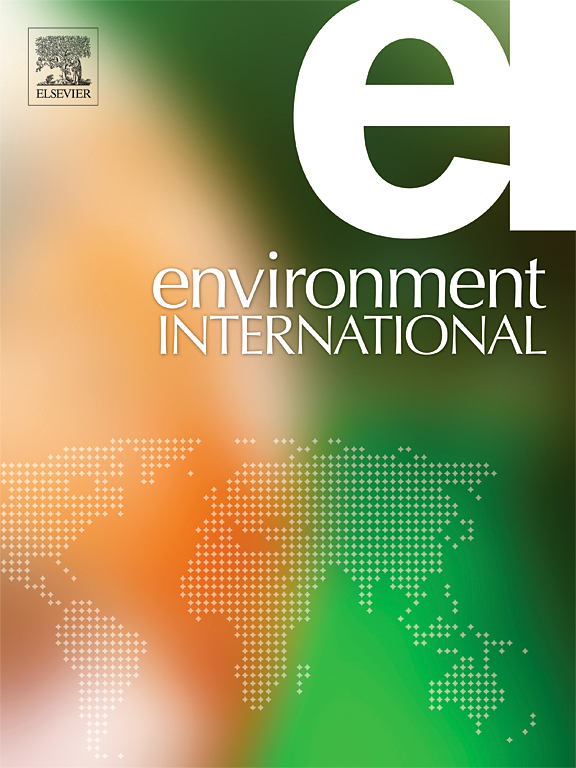A machine learning approach to predict phyllosphere resistome abundance across urbanization gradients
IF 10.3
1区 环境科学与生态学
Q1 ENVIRONMENTAL SCIENCES
引用次数: 0
Abstract
Recent studies reported an increased abundance of antibiotic resistance genes (ARGs) in urban greenspaces, yet the predictability of ARG variance along urbanization gradients remains unclear. We sampled paired soil and phyllosphere samples from the same site in wetland parks along urbanization gradients to assess the correlations of soil and phyllosphere ARG abundance with urbanization indices. Our results revealed that the abundance of phyllosphere resistomes correlated better with urbanization gradients than did that of soil resistomes and increased along urbanization gradients. Moreover, the phyllosphere presented more ARG-MGE (mobile gene element) pairs in metagenome-assembled genomes than soil, suggesting greater transmission potential than soil ARGs. Proximity to the built area and microbial diversity were the most important factors that significantly (p < 0.01) drove the variance in phyllosphere ARG abundance. By integrating population density, land use type, landscape metrics, and air quality data into machine learning models, we predicted phyllosphere ARG abundance at a 10-meter resolution. Among the five tested algorithms tested in the machine learning models (ridge regression, K-nearest neighbor, support vector machine, and neural network), the random forest algorithm achieved the highest accuracy with the lowest root mean square error (27.24 vs. 40.79–46.79 for the other models). These results demonstrate a strong association between phyllosphere ARG abundance and urbanization indices and provide predictions of the potential ARG risk along these gradients. The heightened transmission potential in urban greenspaces may facilitate the spread of antibiotic resistance spread to human pathogens, which poses significant public health threats.


一种预测城市化梯度层状圈抗性组丰度的机器学习方法
最近的研究报道了城市绿地中抗生素耐药基因(ARGs)的丰度增加,但ARG随城市化梯度变化的可预测性仍不清楚。在湿地公园同一地点沿城市化梯度成对取样土壤和层际土壤ARG丰度,探讨土壤和层际土壤ARG丰度与城市化指数的相关性。研究结果表明,层圈抗性基因丰度与城市化梯度的相关性优于土壤抗性基因丰度,且随着城市化梯度的增加而增加。此外,根层圈在宏基因组组装基因组中呈现出比土壤更多的可移动基因元件(ARG-MGE)对,表明比土壤ARGs具有更大的传播潜力。邻近建成区和微生物多样性是影响层圈ARG丰度变化的最重要因素(p <; 0.01)。通过将人口密度、土地利用类型、景观指标和空气质量数据整合到机器学习模型中,我们以10米分辨率预测了层状圈ARG丰度。在机器学习模型(岭回归、k近邻、支持向量机和神经网络)中测试的五种算法中,随机森林算法的准确率最高,均方根误差最低(27.24 vs.其他模型的40.79-46.79)。这些结果表明层状圈ARG丰度与城市化指数之间存在很强的相关性,并提供了沿这些梯度的潜在ARG风险预测。城市绿地传播潜力的增加可能促进抗生素耐药性向人类病原体的传播,这对公共卫生构成重大威胁。
本文章由计算机程序翻译,如有差异,请以英文原文为准。
求助全文
约1分钟内获得全文
求助全文
来源期刊

Environment International
环境科学-环境科学
CiteScore
21.90
自引率
3.40%
发文量
734
审稿时长
2.8 months
期刊介绍:
Environmental Health publishes manuscripts focusing on critical aspects of environmental and occupational medicine, including studies in toxicology and epidemiology, to illuminate the human health implications of exposure to environmental hazards. The journal adopts an open-access model and practices open peer review.
It caters to scientists and practitioners across all environmental science domains, directly or indirectly impacting human health and well-being. With a commitment to enhancing the prevention of environmentally-related health risks, Environmental Health serves as a public health journal for the community and scientists engaged in matters of public health significance concerning the environment.
 求助内容:
求助内容: 应助结果提醒方式:
应助结果提醒方式:


